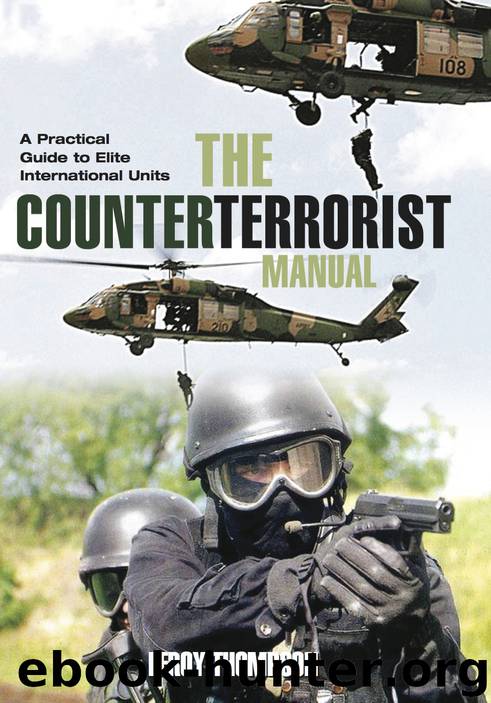The Counterterrorist Manual by Leroy Thompson

Author:Leroy Thompson
Language: eng
Format: epub
ISBN: 9781783469383
Publisher: Frontline Books
Published: 2013-08-21T16:00:00+00:00
Members of Italy’s GIS antiterrorist unit use a special ramp designed for building or aircraft assaults. (Carabinieri)
A five-man entry team from the Austrian military police demonstrate their technique for “stacking.” Note the shield man is aiming his Glock pistol around the shield while other team members have Steyr AUG carbines. The rear man is also armed with a pistol with light mounted; he may be the breacher. (Osterreichs Bundesheer)
Each of the teams will normally have specialist skills among their members. The SAS, for example, will have a squadron assigned to the antiterrorist role, normally for a six-month rotation. Within the squadron will be a HALO/Air Troop, Boat Troop, Mountain Troop, and Mobility Troop, thus providing specialists in various methods of approaching an incident site if needed. There will also be medical, communications, and demolition experts among the personnel. Operators will normally function as either surveillance/snipers or members of assault teams. The SAS normally assigns a portion of the squadron on antiterrorist duty to locations near London. Somewhere between 8 and 16 personnel will normally be assigned to the London area. Their job will be immediate response to an incident while the remainder of the alert squadron is deploying.
The smallest operating element for most antiterrorist teams will consist of four or five men. In the SAS, it is the four-man patrol. The basic operating element will normally be trained to work together clearing rooms or in other assault skills that require choreographed teamwork.
What I have just given is a general overview of organization in antiterrorist units. To gain a better understanding, though, it maybe useful to look at specific units in more detail. In fact, since the SAS has just been used as an example it makes sense to expand on a discussion of its organization first.
The British SAS comes under the command of the Director Special Forces. The regular Army SAS regiment is 22nd SAS. There are also Territorial Army (reserve) units. Primary support elements for the SAS include 18 UKSF Signals Regiment. Many members of this regiment are parachute-trained and some have received additional special operations training. The Special Forces Flights of 7 Squadron at RAF Odiham and 47 Squadron at RAF Lyneham provide air support to the SAS. For MAT operations M Flight of the Fleet Air Arm’s 848 Squadron might be called upon.
The 22nd SAS Regiment is divided into four squadrons, each of which is divided into four troops. Members of Air Troop are trained in static line parachuting, HALO, and HAHO. Although a substantial portion of an SAS squadron may be HALO or HAHO qualified, it is members of Air Troop who are expected to keep up with the latest developments in parachutes, oxygen equipment, GPS steering systems, and other innovations. They will also be charged with checking over their own equipment and that of other operators when carrying out a parachute insertion.
Members of Boat Troop are capable of being inserted in various types of boats. including Klepper canoes, Gemini inflatables, Rigid Raiders, and other craft. They are trained in open and closed circuit scuba techniques and in deployment from submarines.
Download
This site does not store any files on its server. We only index and link to content provided by other sites. Please contact the content providers to delete copyright contents if any and email us, we'll remove relevant links or contents immediately.
Cecilia; Or, Memoirs of an Heiress — Volume 1 by Fanny Burney(32434)
Cecilia; Or, Memoirs of an Heiress — Volume 2 by Fanny Burney(31869)
Cecilia; Or, Memoirs of an Heiress — Volume 3 by Fanny Burney(31852)
The Great Music City by Andrea Baker(31327)
We're Going to Need More Wine by Gabrielle Union(18967)
All the Missing Girls by Megan Miranda(15563)
Pimp by Iceberg Slim(14382)
Bombshells: Glamour Girls of a Lifetime by Sullivan Steve(13972)
Talking to Strangers by Malcolm Gladwell(13222)
Norse Mythology by Gaiman Neil(13204)
Fifty Shades Freed by E L James(13157)
For the Love of Europe by Rick Steves(12931)
Mindhunter: Inside the FBI's Elite Serial Crime Unit by John E. Douglas & Mark Olshaker(9189)
Crazy Rich Asians by Kevin Kwan(9167)
The Lost Art of Listening by Michael P. Nichols(7403)
Enlightenment Now: The Case for Reason, Science, Humanism, and Progress by Steven Pinker(7228)
The Four Agreements by Don Miguel Ruiz(6624)
Bad Blood by John Carreyrou(6545)
Weapons of Math Destruction by Cathy O'Neil(6142)
